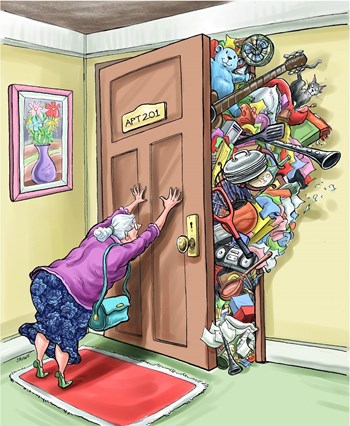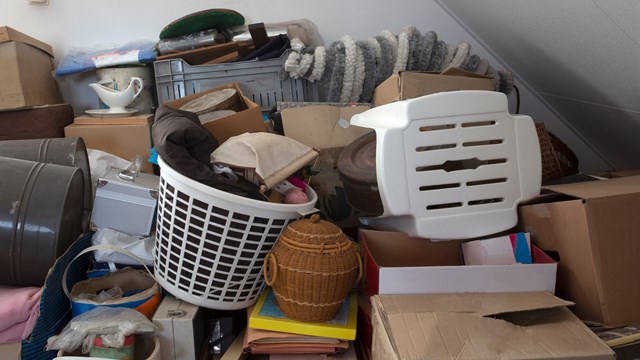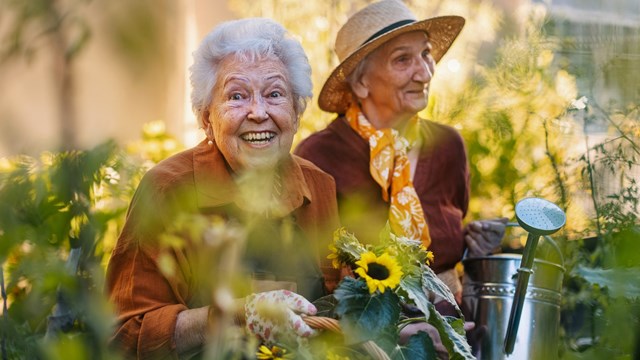
In March 1947, a group of nearly 600 onlookers gathered on the sidewalk in front of the home of bachelor brothers Homer and Langley Collyer on Fifth Avenue and 128th Street in Manhattan. Residents of the neighborhood had speculated and gossiped for years about the two eccentric shut-ins and their crumbling brownstone, which was rumored to be crammed floor-to-ceiling with treasures and curiosities collected by the Collyers over the decades.
It was not until an anonymous tip was phoned in to the NYPD claiming that there was a dead body in the Collyer house that the mystery surrounding the brothers finally unraveled.
Initially, officers responding to the tip were unable to get into the building because the foyer was entirely blocked by a solid wall of junk, including mountains of yellowed newspapers, broken furniture, boxes, and tangled debris. A patrolman eventually broke in through a second-floor window, and after crawling for over two hours through a dark, cramped, foul-smelling maze of thousands upon thousands of objects of all descriptions, he found Homer Collyer's body. There was no sign of Langley.
While search parties looked all over the city for Langley Collyer, workers began clearing the brothers' house of decades' worth of accumulated possessions, trash, and waste. On April 8, 1947 —nearly two weeks after the discovery of Homer Collyer—the badly decomposed body of Langley Collyer was discovered, mere feet away from where his older brother had been found. He had apparently been crushed beneath a landslide of stacked luggage and newspapers.
Ultimately, some 130 tons of junk and garbage were removed from the Collyer house. The vast majority was worthless—the salvageable items netted less than $2,000 at auction—and included things like baby carriages, rusty machinery of all kinds, thousands of books, kitchen utensils, tools, musical instruments, and of course, thousands upon thousands of newspapers and magazines.
Signs and Symptoms
Today, we would say that the Collyer brothers were not merely reclusive and slovenly, but were in fact compulsive hoarders, afflicted with a particular strain of Obsessive Compulsive Disorder (OCD) and in need of therapy and professional cleaning and organization assistance to get their home and lives in order. And they certainly wouldn't be alone; hard numbers are elusive, but according to statistics collected by the University of California San Diego, it's likely that there are about 1.2 million people struggling against obsessive/compulsive hoarding behaviors in the U.S.
According to the International Obsessive Compulsive Disorder (OCD) Foundation, a hoarder is someone who obsessively acquires too many possessions and/or has enormous difficulty discarding or getting rid of them, even if they are no longer useful or needed. Of course, lots of people battle clutter, and lots of people collect things—but when this behavior spirals out of control and threatens a person’s health or safety or leads to distress it becomes a disorder.
According to the Anxiety and Stress Disorders Institute of Maryland, a resource for sufferers of OCD, including compulsive shoppers and hoarders, there are a number of diagnostic criteria indicating that a person may be struggling against more than just a chronic fetish or an overgrown collection of tchotchkes.
According to the ASDI's website, signs of a hoarding disorder vary from person to person, but often include the following:
Saving items seen by most people as unneeded or worthless, (i.e., not true collectibles).
• Compulsively buying or saving excessive quantities of items of any kind.
• Treating all saved items as equally valuable—whether or not the object has sentimental, financial or functional value.
• Experiencing intense anxiety or distress when attempting to discard—or even think about discarding—what most others view as useless objects.
• Engaging in saving activity to combat anxiety-provoking thoughts such as: "What if I run out?" "What if I need to know something and don't have the information available?" "What if I put it away and can't find it?" "What if the way I organize it isn't the right way?" "What if I throw it away but the day comes when I really need it?"
• Being unable to use furniture, rooms, or entire homes in standard ways due to saved items.
• Significant deterioration in housekeeping due to excessive clutter.
Suffering in Silence
Unless you’re granted access to a person's home, it's often hard to tell if someone in your building is struggling with hoarding.
“You won’t likely know a hoarder from meeting them in the street but it’s their behaviors that represent their disorder,” says Lynne Johnson, a certified professional organizer specializing in the chronically disorganized (CPO-CD) in Quincy, Massachusetts. “For example, they may not put out as much trash [for collection], or they may be seen going through others’ trash or discarded junk mail. But you won’t really know they are hoarding unless you see the condition of their living space.”
Other possible indicators are curtains pushed up against windows—typically caused by stacked items in the home—and windows that are closed all year long.
“If no one is ever allowed in the apartment, that’s also a really big red flag,” says Christiana Bratiotis, PhD, director of the Hoarding Research Project at the Boston University School of Social Work. “It’s a recognition that they have some shame or embarrassment or they are fearful that someone will come in and suggest that they throw away possessions.”
Bratiotis also draws distinctions between collectors and true hoarders. “It’s really the interference in carrying on daily activities because of their stuff,” says Bratiotis. “They can’t shower, eat meals in the kitchen or sleep in their bed because there are too many objects in those spaces.”
Hoarding professionals also make a point of distinguishing between hoarding and squalor. “Hoarding is often confused with squalor,” says Bratiotis. “Hoarding refers to the volume of possessions, whereas squalor refers to filth or degradation. You can have hoarding without squalor. Some hoarders even employ cleaning people.”
Television shows such as TLC's Hoarding: Buried Alive may have brought attention to this serious disorder, but for the sake of 'good television,' they typically profile extreme hoarding cases that include profound squalor, serious vermin infestation, or the hoarding of live animals. This may make for riveting TV, but it's not representative of the typical hoarding situation.
Everyone's Problem
When hoarding does involve abject squalor, the situation becomes critical for both the resident and for his or her neighbors, says Patrick J. Brady, a partner at the law firm of Marcus Errico Emmer & Brooks in Braintree, Massachusetts. Brady has seen many hoarding cases, including an extreme squalor case involving a former school teacher who hoarded trash. “The sinks and toilet didn’t work, and there was human waste all over the place," he says. "We got the bathroom functioning, but the smell still lingers—as do the flies.” It's not hard to imagine the impact this resident's situation had on the neighbors.
Johnson says she worked with an elderly food hoarder who had a serious problem with bugs and mice. “He would buy produce in large quantities that was past its prime," she says. "Sometimes it made it to the refrigerator and sometimes it didn’t." The food that didn't provided a feast for all manner of unwanted pests—and those pests didn't just stop at the gentleman's unit; they infiltrated the neighbors' units as well.
It's stories like these that highlight why the issue of hoarding is of great interest to co-op and condo owners and administrators: a hoarding problem doesn’t just affect the hoarder. In an association, where neighbors share walls, ceilings, and floors, there are also safety, comfort, and quality-of-life issues that need to be considered as well. Earlier this year in New Brunswick, New Jersey, a fire left one man dead when firefighters could barely make it inside his home because it was so cluttered. They said that there was little chance of saving the resident because the clutter not only prevented the firefighters from reaching him, but because all the debris acted as fuel for the fire itself, causing it to burn hotter and more quickly.
Legalities and Access
According to Brady, how you treat a hoarding situation in your building depends largely on your governing documents. “Typically, the maintenance provisions state if a unit is causing a hazardous condition, the board can order the unit owner to correct it, or [the board] can excercise the right to access it and take care of it.”
He recommends that property managers contact the city or the fire department or get a court order. “That way,” he says, "if they have to get someone in to clean it up, the association will pay for it and then assess the cost back to the owner. However, if the home goes to foreclosure, there is a good chance that money might not be recovered.” Without a court order, Brady says that managers risk exposing the co-op or condo to liability if they push to go in.
Cleaning it Up
Helping a hoarder requires a unique approach from management and community administrators alike. Demanding that he or she simply clean up the mess won’t work.
“The property manager has a responsibility to the tenants for health and safety violations,” says Johnson, "but if the property manager calls an outside service to come in and just clean the place, it can be so traumatic to the hoarder that their behavior will escalate and the clean unit will fill up again, faster than it originally did.”
Obviously, most property managers aren’t social workers or therapists, and people who hoard compulsively need additional help beyond just clean-up. That part can be tricky, however. “You represent the association, but you can’t tell someone they need therapy,” says Johnson. “All you can say is, ‘Here is the deadline to get this cleaned, so you can get into the apartment.’”
There are other communication strategies for dealing with hoarders, too. "Use their language," says Bratiotis. Approach the person and talk about the greater good of the building.”
Experts also suggest spelling out your building administration's expectations clearly, and in writing. For example, if you need exits and outlets to be clear, state that explicitly. It's also helpful to break down larger tasks into smaller ones, says Bratiotis. “It’s unrealistic to think that it will take one week to [clean a unit] when it didn’t take a week to get like that,” she says. “Imminent risks need to be addressed first.”
Whether a hoarding resident cleans up on their own, with the help of friends and family, or under legal pressure from the building itself, the pros warn administrators to not be surprised if the situation arises again. “It would be very unusual if it didn’t happen again,” says Johnson. “Hoarders have such an emotional attachment that it’s physically painful to let go of those things."
Indeed, the pros agree that in hoarding cases that can be remedied, understanding and support go a lot farther than opprobrium or condemnation. Identifying the problem, reaching out to the struggling resident, clearly stating expectations, and helping them take advantage of the available resources is a more humane, often more effective approach to dealing with the situation. As Johnson stresses, "If the homeowner is willing to address it and the property manager is willing to be patient, it can really benefit things in the long term.”
Lisa Iannucci is a freelance writer and a frequent contributor to The Cooperator.









2 Comments
Leave a Comment